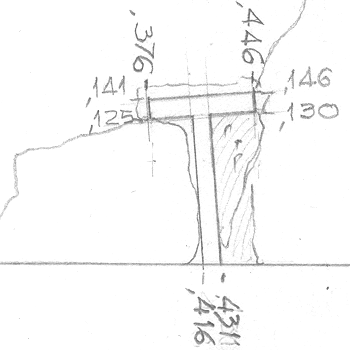
 |
Harrison Eiteljorg, II
In the last issue of the CSA Newsletter, there was a report on the first experiments with scanning Propylaea drawings -- "Scanning Drawings for Preservation and Display -- What Resolution?" vol. XIII.3, Winter 2001. The initial work was done in black-and-white only, and a resolution of 300 d.p.i. was deemed to be sufficient. As reported then, however, substantial problems were encountered when the drawings were reduced for the Web. First, the drawings were simply too large or, if smaller, too low in quality. There is nothing to be done about that problem. Smaller drawings will lose detail; detailed drawings will be too large, both in terms of navigation on screen and transfer time required. Our only choice will be to provide smaller drawings for the Web and full-sized drawings for downloading and eventual use with local software.1
I also reported that screen shots were preferable to reduced-size images of the same size, though I could not understand why. That turned out to be the result of a procedural error. The difference between the quality of the screen shots and the quality of the reduced-size drawings lay in the order in which I changed the drawings from PhotoShop® files to GIF files. I had made screen shots of PhotoShop files when they were shown on screen at smaller sizes, but the other, similarly-sized images had been made into GIF files at the larger size and then reduced. When the images were reduced first in PhotoShop format and then converted to GIF files, the resulting images were of a quality equal to that of the screen shots.


Fig 2. - Gray-scale scan at 600 d.p.i. Resolution
We now have a gray-scale scan to compare to the black-and-white scans done previously, and it is clear that the gray-scale scan is to be preferred. It is not only an issue of clarity but of aesthetics as well, as is apparent in the figures here (to be compared to the eight black-and-white figures in the previous article.) The gray-scale version of the drawing is more readable, because the image is more subtle. The gray-scale version is also more attractive because it is more subtle. There is no doubt in my mind; gray-scale scans of the drawings are better by far, and they will be used for all the Propylaea drawings. The higher-resolution 600 d.p.i. gray-scale scan, however, does not seem to offer more real information than the 300 d.p.i. scan; so scanning will be done at the 300 d.p.i. level. If readers find these or other examples to indicate at different course, I hope they will make their views known.
-- Harrison Eiteljorg, II
To send comments or questions to the author, please see our email contacts page.
1. Readers who read the previous article when it first appeared may have missed a correction. The article has been changed, because the original text indicated that images could not be resized with HTML code. They can. Standard images cannot, however, be dynamically adjusted by the user with a browser. The size dictated by the site designer will be the size shown on screen.
It should be noted that there are ways to provide images at sizes requested by users. This is still not a zoom feature, but a user could specify in advance the size of an image to be displayed, as a percentage of a basic image or even as a specific width in pixels. The basic image would be the largest size provided. Unfortunately, the tools that would make it possible to provide such user-determined image sizes would require that, regardless of display size, the basic image be transferred. As a result, one of the most serious problem of using large images - download time - would be exacerbated. No matter the size requested by a given user, every request for the image would require the downloading of the basic image first. The display size would then be determined as a separate process. Return to body of text.
For other Newsletter articles concerning the Propylaea Project, electronic publishing, or the use of electronic media in the humanities, consult the Subject index.
Next Article: Using the CSA Layer Naming Convention on the Propylaea Model
Table of Contents for the Spring, 2001 issue of the CSA Newsletter (Vol. XIV, no. 1)
 Table of Contents for all CSA Newsletter issues on the Web
Table of Contents for all CSA Newsletter issues on the Web
| Propylaea Project Home Page |
CSA Home Page |